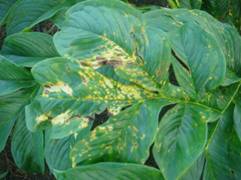Elephant yam (Amorphophallus companulatus Blume)
Araceae
Varieties
Gajendra and Sree Padma are the popular cultivars.
Soil
A rich red-loamy soil with a pH range of 5.5-7.0 is preferred. It is a tropical and subtropical crop. It requires well distributed rainfall with humid and warm weather during vegetative phase and cool and dry weather during the corm development period. |
 |
Season and planting
It undergoes a dormancy period of 45 to 60 days. Traditionally farmers take advantage of the dormancy period by planting during February-March so that the setts would sprout with the pre-monsoon showers. April – May is the planting season. The tuber is cut into 750-1000g small bits in such a way that each bit has atleast a small portion of the ring around each bud. Whole corms of 500 g size can also be used as a planting material. Use of cormels and minisett transplants of 100 g size as planting material at a closer spacing of 45 x 30 cm is also suggested. There are also projections with tender buds called “Arumbu”. These are removed before planting as they do not give vigorous growth. An ordinary sized yam gives about 6 to 8 bits for planting. The cut pieces are dipped in cow dung solution to prevent evaporation of moisture from cut surface. In some places, the small round daughter corms are also planted. The cut pieces are planted in beds at 45 cm x 90 cm spacing or pit of 60 x 60 x 45 cm size is dug and planted. The pit should be filled with top soil and farm yard manure (2kg/pit) prior to planting. The pieces are planted in such a way that the sprouting region (the ring) is kept above the soil. About 3500 kg of corms will be required to plant one hectare. Sprouting takes place in about a month.
Preparation of field
The land is brought to fine tilth and form beds of convenient size.
Planting
The cut pieces are planted in beds at 45 cm x 90 cm spacing. The pieces are planted in such a way that the sprouting region (the ring) is kept above the soil. Sprouting takes place in about a month.
Intercropping
Vegetable cowpea var. CO 2 is recommended as suitable intercrop in elephant foot yam. It can be intercropped profitably in coconut, arecanut, rubber, banana and robusta coffee plantations at a spacing of 90 x 90 cm. Half quantity of FYM (12.5 t/ha) and one third of NPK (27:20:33) will be sufficient for the intercrop.
Irrigation
It is mostly raised as a rainfed crop. However, irrigation is required when monsoon fails, where it is grown on a large scale. Water stagnation is harmful to the crop. Wherever irrigation facility is available, irrigation can be given once a week.
Application of fertilizers
Apply 25 tonnes of FYM/ha during last ploughing. The recommended dose of NPK/ha is 80:60:100 kg. Apply 40:60:50 kg NPK/ha at 45 days after planting along with weeding and intercultural operations. Top dress with 40:50 N and K one month later along with shallow intercultural operations.
After cultivation
Weeding and earthing up as and when necessary.
Plant protection
Disease
Leaf spot
Leaf spot disease can be controlled by spraying Mancozeb at 2 g/lit.
 Leaf spot disease
Leaf spot disease Collar rot
The disease is caused by a soil borne fungus Schlerotium rolfsii. Water logging, poor drainage and mechanical injury at collar region favour the disease incidence. Brownish lesions first occur on collar regions, which spreads to the entire pseudostem and cause complete yellowing of the plant. In severe case, the plant collapses leading to complete crop loss.
Management
Use disease free planting material, remove infected plant materials, improve drainage conditions, incorporate organic amendments like neem cake, drench the soil with carbenilazim or apply biocontrol agents like Trichoderma harzianumI @ 2.5 kg/ha mixed with 50kg of FYM (lg/l of water).
Harvest
Harvesting is done on 8 months after planting and particularly during January - February months. Drying of stem and leaves indicates the harvesting stage in elephant yam.
Yield
The crop can yield about 30 – 35 t/ha in 240 days.
For seed purpose, the yams can be left in the field itself till planting the next crop or the lifted yams can be stored in sand or paddy straw.
|


